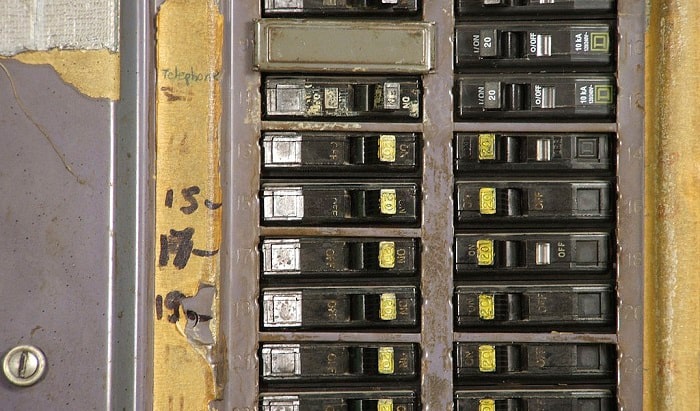Table of Contents
Do you have a furnace unit in your house? Do you have an idea where is the furnace circuit breaker of your home? It’s crucial you know which of the breakers in your central breaker panel services your furnace, so you know how to switch it off.
In case of an emergency, you can cut off its power directly from your panel box. It’s also helpful to know if you need to clean, maintain, or repair your house furnace. The easiest way to determine which breaker handles your furnace’s power is to look at the panel labels.
But what if the labels are illegible, or worse, missing? Read on to find out how to trace your furnace’s circuit breaker.
How to Identify the Furnace Breaker Switch
Your furnace would have a dedicated circuit breaker right in your panel box. A furnace usually has a double-pole breaker because of its high electricity loads, which are usually between 60 to 80 amps. So if you have a furnace and see a double-pole breaker in your panel, that’s probably it.
However, to confirm your hypothesis, you need to test that circuit breaker to see if it actually services your furnace. There are two ways to do this:
- Use a circuit breaker finder
- Switch off the breaker and see if it cuts off power to your furnace
A circuit breaker finder will help you trace the actual breaker of your furnace. If the furnace doesn’t come with its own exclusive outlet where you can plug your circuit breaker finder, you’ll have to connect the included alligator clips on exposed wires to trace it.
Randomly switching off breakers to see which one cuts off power to your furnace can work, too. However, this isn’t advisable since it can damage the furnace fuse box due to sudden loss of electricity.
Furnace Disconnect Switch vs. Furnace Circuit Breaker
If you look at your furnace and its environment, you might have noticed a secondary switch on or near it. This is a furnace disconnect switch, also called a furnace on-off switch. It’s usually located on the side or top of your machine. It can also sometimes be found mounted on the wall near it.
This is because the furnace disconnect code often requires this switch to be close to your furnace.
This switch adds a layer of safety to operating your furnace. That’s because it’s always within reach of it, so if you see something wrong with your machine, you can easily switch it off—no need to run up to your main breaker panel.
It also adds a layer of protection to people working on the furnace. With this switch, they can ensure that the machine has no power by visually inspecting the switch.
Furthermore, this switch is required by most state electrical standards. Furthermore, because high-powered appliances must have their own circuit branch, you must isolate a furnace from the rest of your electrical system.
The disconnect switch is different from the furnace circuit breaker, which is placed inside your main breaker panel and is designed to cut off power from the primary power source. So if you see a switch near your furnace—that is the assigned furnace disconnect switch and not the furnace circuit breaker.
Two Types of Furnace Disconnect Switches
1. Standard Single-Pole Switch
Most modern heaters use an electrical or gas furnace circuit breaker. These standard single-pole switches look very similar to the switch you see for your light.
They must have their own external housing to protect the wires and cable inside. Furthermore, they must have the proper voltage and amp rating to accommodate your furnace’s requirements.
2. Toggle Switch with Fuse
Some older furnace models connect to your main panel box via a toggle switch with a fuse. For this switch type, you can flip the toggle to turn your furnace on and off. Alternatively, you can remove the fuse to ensure the switch is in the off position and that the furnace isn’t accidentally turned on.
What If You Can’t Find a Furnace Switch
Both switch types add a layer of safety to your furnace. However, if you find neither of them installed in your system, check your main panel box to see if the furnace installer used a lockable breaker instead.
Although it does provide some protection against accidents, having a lockable breaker is not an advisable arrangement. This is because you do not have easy access to the switch, especially if your furnace is far from your main breaker panel.
Furthermore, when you’re repairing your furnace, someone else could accidentally switch on the furnace’s breaker without your knowledge. An independent furnace switch would be located near the furnace itself, so you can power off the furnace easily.
Conclusion
When you know where is the furnace circuit breaker switch, you’ll have more confidence in your heating system. You can now switch it off in your main breaker panel in case of an emergency. And in case the dedicated furnace switch is closer to you, you can turn the furnace off using that as well.
With both a furnace circuit breaker and a furnace switch, you and your home are protected from any accidents. Furthermore, it makes caring for your machine easier and quicker.
Were you able to find your furnace’s switch? What type of switch do you have installed? Share it in the comments section below!

I am Edwin Jones, in charge of designing content for Galvinpower. I aspire to use my experiences in marketing to create reliable and necessary information to help our readers. It has been fun to work with Andrew and apply his incredible knowledge to our content.



